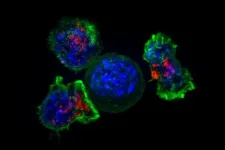Robotic neck brace can help analyze cancer treatment impacts
The new device from Columbia Engineering could help guide recovery after treatment for head and neck cancer
2021-07-19
(Press-News.org) New York, NY--July 19, 2021-- A new robotic neck brace from researchers at Columbia Engineering and their colleagues at Columbia's Department of Otolaryngology may help doctors analyze the impact of cancer treatments on the neck mobility of patients and guide their recovery.
Head and neck cancer was the seventh most common cancer worldwide in 2018, with 890,000 new cases and 450,000 deaths, accounting for 3% of all cancers and more than 1.5% of all cancer deaths in the United States. Such cancer can spread to lymph nodes in the neck, as well as other organs in the body. Surgically removing lymph nodes in the neck can help doctors investigate the risk of spread, but may result in pain and stiffness in the shoulders and neck for years afterward.
Identifying which patients may have issues with neck movement "can be difficult, as the findings are often subtle and challenging to quantify," said Scott Troob, assistant professor of otolaryngology - head and neck surgery and division chief of facial plastic and reconstructive surgery at Columbia University Irving Medical Center. However, successfully targeting what difficulties they might have with mobility can help patients benefit from targeted physical therapy interventions, he explained.
The current techniques and tools that doctors have to judge the range of motion a patient may have lost in their neck and shoulders are somewhat crude, explained Sunil K. Agrawal, a professor of mechanical engineering and rehabilitative and regenerative medicine and director of the ROAR (Robotics and Rehabilitation) Laboratory at Columbia Engineering. They usually either provide unreliable measurements or require too much time and space to set up for use in routine clinical visits.
To develop a more reliable and portable tool to analyze neck mobility, Agrawal and his colleagues drew inspiration from a robotic neck brace they previously developed to analyze head and neck motions in patients with amyotrophic lateral sclerosis (ALS). In partnership with Troob's group, they have now designed a new wearable robotic neck brace. Their study appears July 12 in the journal Wearable Technologies.
The new brace was made using 3D-printed materials and inexpensive sensors. The easy-to-wear device was based on the head and neck movements of 10 healthy individuals.
"This is the first study of this kind where a wearable robotic neck brace has been designed to characterize the full head and neck range of motion," Agrawal said.
In the new study, the researchers used the prototype brace, along with electrical measurements of muscle activity, to compare the neck mobility of five cancer patients before and one month after surgical removal of neck lymph nodes. They found their device could precisely detect changes in patient neck movements during routine clinical visits.
"Use of the sensing neck brace allows a surgeon to screen patients postoperatively for movement difficulty, quantify their degree of impairment, and select patients for physical therapy and rehabilitation," Troob said.
"Patients consistently identify need for rehabilitation and guided exercises after surgery as an unmet need in their medical care," Troob said. "This work will lay the foundation for the appropriate identification of patients for intervention. We additionally hope that through using the neck brace, we will be able to objectively quantify their improvement and develop evidence-based rehabilitative programs."
In the future, the researchers hope to investigate larger groups of patients and use the neck brace to follow patients through physical therapy to develop evidence-based protocols for rehabilitation, Troob said. They also would like to develop similar braces for other surgical sites, such as the forearm, ankle, or knee, he added.
INFORMATION:
About the Study
The study is titled "A novel neck brace to characterize neck mobility impairments following neck dissection in head and neck cancer patients."
The study appeared in the journal Wearable Technologies on July 12, 2021.
Authors are: Biing-Chwen Chang, Haohan Zhang, Sallie Long, Adetokunbo Obayemi, Scott H. Troob and Sunil K. Agrawal.
Department of Mechanical Engineering, Columbia Engineering
Department of Otolaryngology--Head and Neck Surgery, Columbia University Irving Medical Center
This work received funding from NSF IIS-1527087 and New York State Grants C31290GG and C32238GG.
LINKS:
Paper: https://doi.org/10.1017/wtc.2021.8
DOI: 10.1017/wtc.2021.8
http://engineering.columbia.edu/
https://www.me.columbia.edu/
https://www.entcolumbia.org/
https://www.entcolumbia.org/profile/stroob
https://www.me.columbia.edu/faculty/sunil-agrawal
https://roar.me.columbia.edu
https://www.nejm.org/doi/full/10.1056/NEJMra1715715
https://onlinelibrary.wiley.com/doi/10.1002/acn3.50864
Columbia Engineering
Columbia Engineering, based in New York City, is one of the top engineering schools in the U.S. and one of the oldest in the nation. Also known as The Fu Foundation School of Engineering and Applied Science, the School expands knowledge and advances technology through the pioneering research of its more than 220 faculty, while educating undergraduate and graduate students in a collaborative environment to become leaders informed by a firm foundation in engineering. The School's faculty are at the center of the University's cross-disciplinary research, contributing to the Data Science Institute, Earth Institute, Zuckerman Mind Brain Behavior Institute, Precision Medicine Initiative, and the Columbia Nano Initiative. Guided by its strategic vision, "Columbia Engineering for Humanity," the School aims to translate ideas into innovations that foster a sustainable, healthy, secure, connected, and creative humanity.
ELSE PRESS RELEASES FROM THIS DATE:
2021-07-19
CT scans for patients with concussion provide critical information about their risk for long-term impairment and potential to make a complete recovery - findings that underscore the need for physician follow-up.
In a study led by UC San Francisco, researchers looked at the CT scans of 1,935 patients, ages 17 and over, whose neurological exams met criteria for concussion, or mild traumatic brain injury (TBI), at hospitals throughout the nation. While links between CT imaging features and outcome have already been established in moderate and severe TBI, the researchers believe this is the first time the link has been identified in patients ...
2021-07-19
Hamilton, ON (July 19, 2021) - A potentially game-changing treatment for people with, or at risk of, blood clots has been found effective by an international team of researchers led by McMaster University's Jeffrey Weitz.
Weitz's team compared abelacimab with enoxaparin as a control drug in 412 patients undergoing knee replacement surgery. Results showed that just one abelacimab injection prevents blood clots for up to a month after surgery, reducing the risk by about 80% compared with enoxaparin without increasing the risk of bleeding.
Their findings were published in the New England Journal of Medicine today, coinciding with Weitz's presentation of the research at the International Society on Thrombosis and Hemostasis 2021 Congress.
Weitz, a hematologist, is a professor of medicine ...
2021-07-19
What The Study Did: This study investigated the association between time spent cycling and the risk of death from cardiovascular disease or any other cause among people with diabetes.
Authors: Mathias Ried-Larsen, Ph.D., of Rigshospitalet in Copenhagen, is the corresponding author.
To access the embargoed study: Visit our For The Media website at this link https://media.jamanetwork.com/
(doi:10.1001/jamainternmed.2021.3836)
Editor's Note: The article includes conflicts of interest and funding/support disclosures. Please see the article for additional information, including other authors, author contributions and affiliations, conflict of interest and financial disclosures, and funding and support.
# # #
Media advisory: The full study and editor's note are ...
2021-07-19
What The Study Did: The experiences, perspectives and needs of transgender young people in accessing health care are described in this review of 91 studies.
Authors: Lauren S. H. Chong, M.D., of the Children's Hospital at Westmead in Sydney, Australia, is the corresponding author.
To access the embargoed study: Visit our For The Media website at this link https://media.jamanetwork.com/
(doi:10.1001/jamapediatrics.2021.2061)
Editor's Note: The article includes conflict of interest disclosures. Please see the article for additional information, including other authors, author contributions and affiliations, conflict of interest and financial disclosures, and funding and support.
# ...
2021-07-19
What The Study Did: These results suggest that substantial proportions of Latinx immigrants have immigration concerns about engaging in COVID-19-related testing, treatment and contact tracing.
Authors: Carol L. Galletly, J.D., Ph.D., Medical College of Wisconsin in Milwaukee, is the corresponding author.
To access the embargoed study: Visit our For The Media website at this link https://media.jamanetwork.com/
(doi:10.1001/jamanetworkopen.2021.17049)
Editor's Note: The article includes conflict of interest and funding/support disclosures. Please see the article for additional information, including other authors, author contributions and affiliations, conflict of interest and financial disclosures, and funding and support.
# # ...
2021-07-19
What The Study Did: The association between daily coffee consumption and the risk of cardiac arrhythmias was evaluated in this study.
Authors: Gregory M. Marcus, M.D., M.A.S., of the University of California, San Francisco, is the corresponding author.
To access the embargoed study: Visit our For The Media website at this link https://media.jamanetwork.com/
(doi:10.1001/jamainternmed.2021.3616)
Editor's Note: The article includes conflicts of interest and funding/support disclosures. Please see the article for additional information, including other authors, author contributions and affiliations, conflict of interest and financial disclosures, and funding and support.
# # #
Media advisory: The full study and commentary are ...
2021-07-19
What The Study Did: This study included a meta-analysis that combined the results of 74 studies with 2.7 million participants to estimate how common globally dementia is in people younger than age 65.
Authors: Sebastian Köhler, Ph.D., of Maastricht University in Maastricht, the Netherlands, is the corresponding author.
To access the embargoed study: Visit our For The Media website at this link https://media.jamanetwork.com/
(doi:10.1001/jamaneurol.2021.2161)
Editor's Note: The article includes conflicts of interest and funding/support disclosures. Please see the article for additional information, including other authors, author contributions and affiliations, conflict of interest and financial disclosures, and funding and ...
2021-07-19
What The Study Did: Researchers examined racial/ethnic disparities in outpatient visit rates to 29 physician specialties in the United States.
Authors: Christopher Cai, M.D., of the Internal Medicine Residency Program at Brigham and Women's Hospital/Harvard Medical School in Boston, is the corresponding author.
To access the embargoed study: Visit our For The Media website at this link https://media.jamanetwork.com/
(doi:10.1001/jamainternmed.2021.3771)
Editor's Note: The article includes conflicts of interest disclosures. Please see the article for additional information, including other authors, author contributions and affiliations, conflict of interest and financial disclosures, and funding and support.
INFORMATION:
Media advisory: The full study is linked to this news release.
Embed ...
2021-07-19
An international team anchored by the Event Horizon Telescope (EHT) Collaboration, which is known for capturing the first image of a black hole in the galaxy Messier 87, has now imaged the heart of the nearby radio galaxy Centaurus A in unprecedented detail. The astronomers pinpoint the location of the central supermassive black hole and reveal how a gigantic jet is being born. Most remarkably, only the outer edges of the jet seem to emit radiation, which challenges our theoretical models of jets. This work, led by Michael Janssen from the Max Planck Institute for Radio Astronomy ...
2021-07-19
LA JOLLA--Fighting a tumor is a marathon, not a sprint. For cancer-fighting T cells, the race is sometimes just too long, and the T cells quit fighting. Researchers even have a name for this phenomenon: T cell exhaustion.
In a new Nature Immunology study, researchers at La Jolla Institute for Immunology (LJI) report that T cells can be engineered to clear tumors without succumbing to T cell exhaustion.
"The idea is to give the cells a little bit of armor against the exhaustion program," says LJI Professor Patrick Hogan, Ph.D. "The cells can go into the tumor to do their job, ...
LAST 30 PRESS RELEASES:
[Press-News.org] Robotic neck brace can help analyze cancer treatment impacts
The new device from Columbia Engineering could help guide recovery after treatment for head and neck cancer


